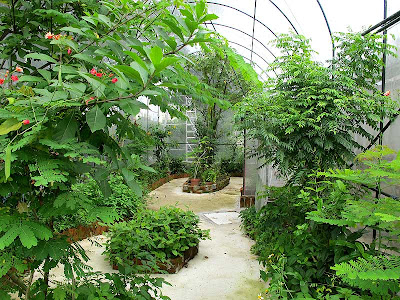Butterfly Lodge @ Oh' Farms V 2.0
Bigger, Better, More Butterflies!
Time really flies! It was in Aug 2008 when the Butterfly Lodge at Oh' Farms in Sembawang was first opened for "business". Then intended to be an experimental project to create an educational and butterfly appreciation facility for students and nature lovers, the small butterfly aviary was born.
The flight cage took a simple L-shaped design, with a barrel-vaulted roof. The material for the netting was selected to allow an adequate amount of light to enter the enclosure, but with a mesh that is fine enough to keep the butterflies in, but predators and other vermin out.
The project was successful beyond our imagination, as many classes of primary school kids were educated and entertained with fun knowledge about butterflies. The kids saw for themselves how butterflies survived in the environment, as well as their early stages.
It is hoped that seeds from the lessons on butterfly conservation would have been planted in these young minds so that they too can share their knowledge in future.
The caterpillar breeding efforts by the staff of Oh' Farms also bore fruit, as it became a relatively well-known source for caterpillars and students from various local schools who wanted to study the metamorphosis of butterflies as a science project, often sourced for the caterpillars from Oh' Farms.

Caterpillar kits were sold to the school children with the appropriate host plants. These kits contained primarily the final instar caterpillars so that the kids can enjoy the wonders of seeing the caterpillar turn into a pupa, and then emerge as a beautiful butterfly. The parents of the kids were also briefed to return the eclosed adult butterflies to the wild, or bring them back to the Butterfly Lodge for release.
The educational and conservation efforts continued, with Oh' Farms collaborating with ButterflyCircle, and NParks to try to encourage schools to cultivate the Common Birdwing's host plants in their gardens. This was the "Save the Common Birdwing" project.
After 3 years of operations, and thousands of school children visiting the Butterfly Lodge, the cramped butterfly aviary posed challenges for large classes of children visiting the facility. Very often, the class had to be split into two groups with a short outdoor class 'lecture' whilst the other half of the class would be in the aviary.
The owner of Oh Farms, Yeok Keong, decided to expand the facility to accommodate a larger group of students as well as feature more plants and species of butterflies. The work started some time in Aug 2011, and the new and expanded Butterfly Lodge was completed in Oct.
With a footprint of slight more than double the original size of the Butterfly Lodge, the expanded butterfly aviary was also taller. The concrete paths within the aviary was also made wider to allow for better circulation.
More plants were collected and organised within the butterfly aviary. Amongst some of the new plants were the host plants for the Malayan Eggfly, as well as more variety of nectaring plants.
The all-time favourite, Bidens sp. with its pretty white-and-yellow flowers spread extensively across many of the main planters, supplemented with other types of nectaring plants like the Common Snakeweed, Lantana and so on.
A new addition is a small arch with pretty Honolulu Creeper (Antigonon leptopus) creepers adorning it. I also saw a pot of Pink Snakeweed (Stachytarpeta mutabilis var. mutabilis) and some small shrubs of Golden Dewdrop (Duranta erecta) with its pretty violet flowers as part of the nectaring buffet for the butterflies.
I visited the new Butterfly Lodge V 2.0 with Federick on a weekend in early October to check it out. We were both pleasantly surprised at the number of butterflies fluttering around in the aviary. It was amazing, considering that out in the wild, it was off-season for butterflies and not many were seen around.

But within the aviary, it was butterfly haven. Flying around were quite a number of species that were recent additions, like the Malayan Eggfly, Pea Blue, Lemon Emigrant and the return of the Blue Pansy which had disappeared for quite some time.
The loftier ceiling height of the new aviary appears to give a better sense of spatiousness and the butterflies also look happier too! It was also slightly easier to photograph the butterflies as there was ample space to compose the subjects with better backgrounds than in the previous cramped aviary.
 |
The Pea Blue - a new addition to Butterfly Lodge |
All in all, the expanded Butterfly Lodge is definitely worth another visit. Just standing in there, and watching the gentle and beautiful flying jewels is very therapeutic.

There are many observations of butterfly behaviour that one can get from watching them fly, frolick with each other, feed, engage in courtship and mating rituals, ovipositing and so on. A wonder of Mother Nature that cannot be expressed in words alone.
Kudos to Yeok Keong and the staff of Oh' Farms for creating the Butterfly Lodge V 2.0 and the hard work of maintaining and sustaining this excellent nature conservation and education facility in Singapore.
Note : Visitors will be charged a nominal entrance fee of S$4 to enjoy the Butterfly Lodge. There is no time limit for your stay there.














































